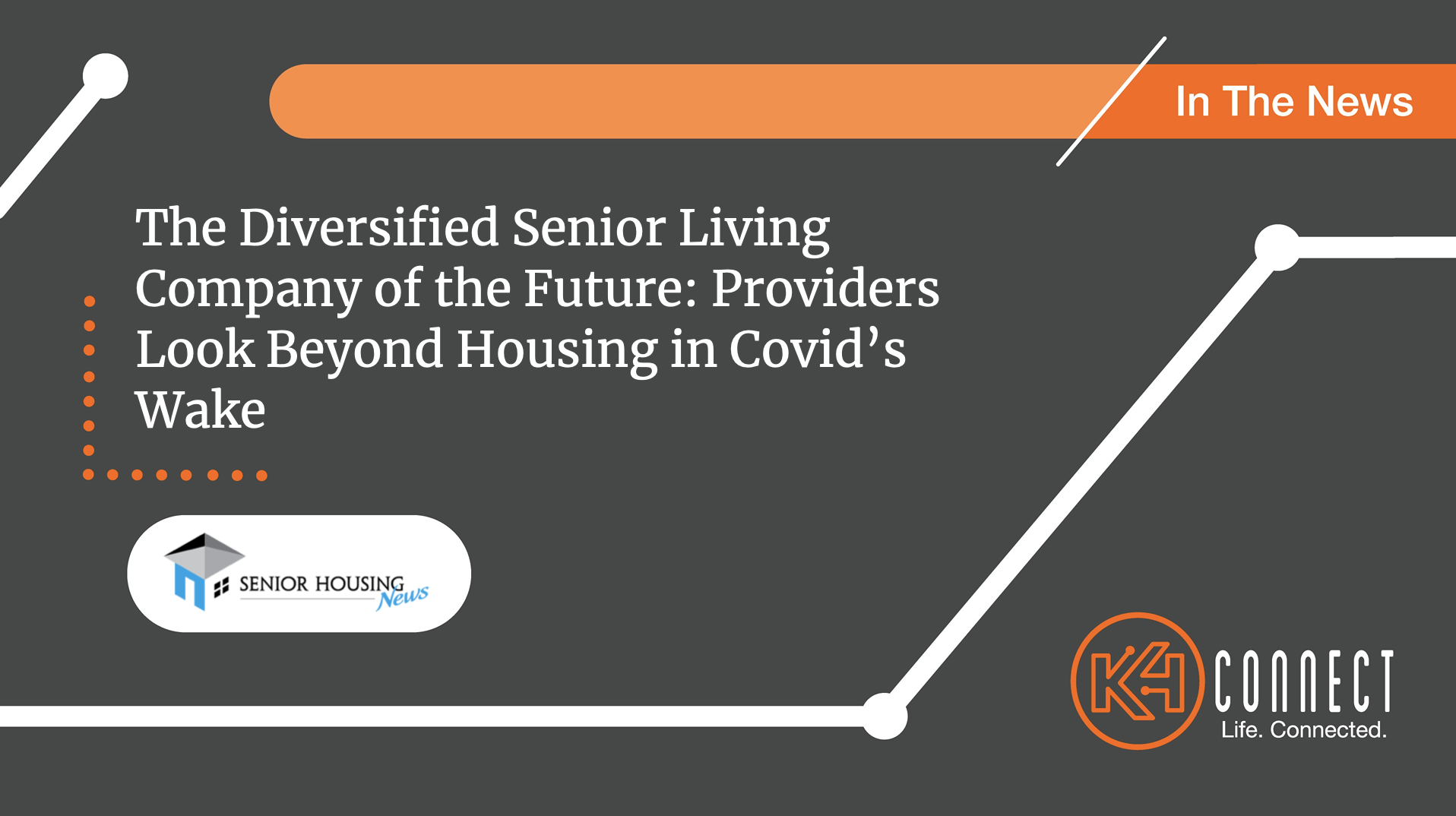There are signs that Covid-19 has propelled more senior living providers to consider diversification strategies, adding new ancillary service lines as a financial and strategic play.
October 25, 2021
By: Tim Regan
The trend was already underway before the pandemic struck, but with Covid-19 eroding occupancy to historically low levels, providers have recognized the risks in tying revenue almost entirely to census.
“I … knew that 98% of our revenue comes from CCRCs, from the resident rates, so you have to think, ‘How do I continue moving forward, investing in infrastructure, investing in innovation, investing in our workforce, and growth in all the things we want to do by just relying on resident rates?’” Asbury Communities CEO Doug Leidig said earlier this year during an interview for Senior Housing News’ Changemakers series.
The pandemic added further urgency to Asbury’s quest to become a “diversified aging services organization” — and Asbury is not alone.
Publicly traded senior living provider Five Star Senior Living (Nasdaq: FVE) has for years tended to a growing rehabilitation service line dubbed Ageility. And the provider’s leadership foresees a future in which Five Star is even more diversified, in order to serve the new generation of consumers in a variety of settings.
Indeed, even as Covid-19 highlighted the need for more diverse revenue streams, the pandemic reinforced consumer preferences for at-home care, prompting even more senior living providers — including Bickford Senior Living — to consider branching out into these service lines.
The strategy is not easy to execute; many senior living providers have been successful by sticking to the business they know best. But providers that are pursuing diversification believe that by investing the necessary time and resources into creating multiple sustainable service lines, they will be positioned to serve future consumers and withstand market shocks.
“A lot of the services that we’ve been working on are about positioning ourselves for the future so that the businesses … will create revenue over time, and not just that quick-punch revenue that can sometimes fade,” Asbury’s President of Integrated Services Shaun Smith told SHN.
Data fills in the picture
Despite the rise of ancillary services in recent years, there are many senior living providers who did not create new service lines in 2020. This is unsurprising, given that providers were focused on rising to pressing pandemic challenges last year, but new data compiled by HealthTrust COO Colleen Blumenthal for an upcoming ASHA study helps fill in the picture, showing that some types of communities bucked the overall trend.
Among the 737 properties in the survey’s same-store sample that reported ancillary revenues, 59% said they did not increase ancillary revenues in 2020.
However, the surveyed assisted living communities reported a 26% increase in ancillary revenues, going from an average of $572 ancillary revenue per occupied unit in 2019 to $735 in 2021.
Combination assisted living and memory care communities saw 8% higher ancillary revenue last year, going to an average of $1,037 per occupied unit in 2020 from $958 in 2019.
And ancillary revenue for independent living communities grew 6%, increasing from an average of $270 per occupied unit in 2019 to $287 in 2020.
While certain care types grew their ancillary revenue last year, these revenues fell for others. Standalone memory care providers reported a whopping 41% less ancillary revenue in 2020, dropping to an average per occupied unit of $315 in 2020, which is down from $529 in 2019. Similarly, continuing care retirement communities saw 12% less revenue from ancillary services last year, decreasing to $3,785 in 2020 from $4,312 in 2019.
Communities with independent living, assisted living and memory care units saw about 5% less ancillary revenue in 2020, while IL/AL communities remained about flat.
Ancillary Service Strategies
While 2020 was a difficult year to embark on new ancillary service initiatives, some providers did go down that road — and their experience suggests the benefits of this strategy and suggests that other organizations may be wise to undertake similar efforts as pandemic challenges recede.
Frederick, Maryland-based Asbury affiliated with Albright Care Services at the start of 2020. The affiliation brought together Albright, a Pennsylvania organization with two retirement communities, three “LIFE” centers offering Living Independence for the Elderly services (known as PACE, or Programs of AllInclusive Care for the Elderly, in other states), a small home health line and a pharmacy service line; and Asbury, which in addition to its continuing care retirement communities (CCRC) also offered home-based services.
About three months into the affiliation, Covid-19 hit. But that didn’t deter Asbury from pursuing a new way to offer rehab services. The organization soon formed a joint venture with Flagship Rehabilitation to create Edge Therapy Solutions, an inhouse rehabilitation therapy service.
Under the JV, Flagship provides two regional staffers focused on compliance and management as well as rehab directors in all nine Asbury campuses.
“The whole premise was that you can save money by having your own in-house therapists,” Smith said.
While setting up a rehab therapy joint venture in the middle of a pandemic was not an easy task, Smith said Asbury saved money amid Covid by doing so.
“We really haven’t missed a beat on the revenue side,” Smith said. “We’ve been able to keep more of that revenue because we’re not sharing it with a therapy company, and we have also been able to develop some additional services in outpatient.”
Bickford is another company that has diversified its services. In June, Bickford launched a new home care service line with HomeCare Advocacy Network (HCAN) called “Bickford Home Care,” at four of its locations — in Chicago, in the Cedar Rapid/Iowa City market, and in the Muscatine/Quad cities market. The company is also launching its own hospice service at Bickford communities in some markets.
Bickford Executive Vice President of Operations Alan Fairbanks told Senior Housing News that although diversifying revenue was not the primary driver behind the moves — instead, it was aimed more at serving older adults where they are choosing to age — it did factor into the Olathe, Kansas-based company’s decision. And he took a similar view of revenue and savings as Smith and Asbury.
“It is an additional revenue stream,” Fairbanks told SHN. “But I don’t know that I would use the word ‘diversification’ because to me … it’s vertical integration, and we’re going to be providing care and services as Bickford to our residents versus outsourcing that care and services to other providers.”
Home-based care is a service line more frequently seen in nonprofit operators, who usually have a mission to serve older adults, both those living in their communities as well as beyond their walls.
About 45% of the operators featured in the 2021 LeadingAge Ziegler 200 — which covers the 200 largest non-profit operators in the U.S. — reported offering home- and community-based services to non-residents in 2021.
Of those services, home care and home health care were most popular, with 30% and 25%, operators reporting offering those services, respectively; followed by hospice (17%) adult day care (16%), continuing care at home (10%) and PACE (7%).
However, Bickford is far from the only for-profit organizations that is active in the at-home care space and looking to expand ancillary services further.
Another operator interested in home care is Kansas City, Missouri-based Tutera Senior Living and Health Care, which has 75 communities in nine states, one third of which are senior living. Though Tutera COO Randy Bloom said the company is already diversified with a home health care business among other in-house services, it is still looking to expand into other service lines, such as hospice, pharmacy, lab services, transportation and therapy.
“There’s nothing really off the table,” Bloom told SHN.
The pace of diversification is an open question — most providers working with Scott Moody, co-founder and CEO of senior living tech provider K4Connect, are still focused primarily on occupancy recovery at this stage in 2021.
Other trends Moody sees include senior living providers expanding into tech-enabled ancillary services for non-residents such as fall-detection, home automation, check-in capabilities or remote monitoring; and capturing a portion of insurance or health care costs, such as by offering services that are paid through Medicare Advantage.
“Some people have started to play in Medicare Advantage, where if they do take better care of that person, then they have the advantage,” Moody said. “[Tech-enabled services for nonresidents], fewer people are looking at that … but we’re definitely looking at that with some active adult communities.”
>>Read the full article on Senior Housing News


